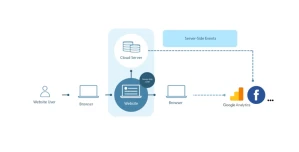Over the past few months, we have spoken a lot about the importance of collecting 1st party data; especially for ecommerce brands. The easiest and most efficient way of doing this it to implement a server side tracking solution but how exactly is this different to your current set up and how does server side tracking work?
To start with, it's good to understand how we've been tracking activity prior to the privacy updates and how 1st party and 3rd party cookies work.
How 3rd party tracking works.
Before the privacy revolution, any website was able to track website activity through the use of 3rd party cookies.
When users land on a website, they are assigned an cookie ID; this cookie carries all the data around the users data and activity. This ID is then sent to the browser and can be passed back and forth between the browser and web pages in order to capture user behaviour data. It's called a 3rd party cookie because the cookie is from another website than the one the user is visiting.
For example, a user visits a website called luxuryfashion.com. Cookies placed on this domain by luxuryfasion.com are first-party cookies (something we'll cover in a moment.) A cookie placed by any other site, such as a browser, advertiser or social media site, is a 3rd party cookie.
Blocking 3rd party cookies.
iOS14 and browser privacy updates block 3rd party cookies by recognising those cookies which have been placed by a 3rd party domain and stopping them from being actioned.
When you set up tracking and analytics through Google Tag manager, this is what the code source in the header of your website should look like.

As you can see googletagmanager.com is listed as the tracking domain. This is a 3rd party domain therefore we would expect a large proportion of cookies to be blocked by operating systems, browsers and privacy settings.
Let's look at the workaround.
What is a 1st party cookie?
1st party cookies are cookies hosted by the domain the user is visiting. Most of the time these cookies are placed to remember log in details or contents of your shopping basket and remain on the site without sending user's data to any other 3rd party platform that the user is unaware of.
Over the past few months, we have spoken a lot about the importance of collecting 1st party data; especially for ecommerce brands. The easiest and most efficient way of doing this it to implement a server side tracking solution but how exactly is this different to your current set up and how does server side tracking work?
To start with, it's good to understand how we've been tracking activity prior to the privacy updates and how 1st party and 3rd party cookies work.
How 3rd party tracking works.
Before the privacy revolution, any website was able to track website activity through the use of 3rd party cookies.
When users land on a website, they are assigned an cookie ID; this cookie carries all the data around the users data and activity. This ID is then sent to the browser and can be passed back and forth between the browser and web pages in order to capture user behaviour data. It's called a 3rd party cookie because the cookie is from another website than the one the user is visiting.
For example, a user visits a website called luxuryfashion.com. Cookies placed on this domain by luxuryfasion.com are first-party cookies (something we'll cover in a moment.) A cookie placed by any other site, such as a browser, advertiser or social media site, is a 3rd party cookie.
Blocking 3rd party cookies.
iOS14 and browser privacy updates block 3rd party cookies by recognising those cookies which have been placed by a 3rd party domain and stopping them from being actioned.
When you set up tracking and analytics through Google Tag manager, this is what the code source in the header of your website should look like.

As you can see googletagmanager.com is listed as the tracking domain. This is a 3rd party domain therefore we would expect a large proportion of cookies to be blocked by operating systems, browsers and privacy settings.
Let's look at the workaround.
What is a 1st party cookie?
1st party cookies are cookies hosted by the domain the user is visiting. Most of the time these cookies are placed to remember log in details or contents of your shopping basket and remain on the site without sending user's data to any other 3rd party platform that the user is unaware of.






